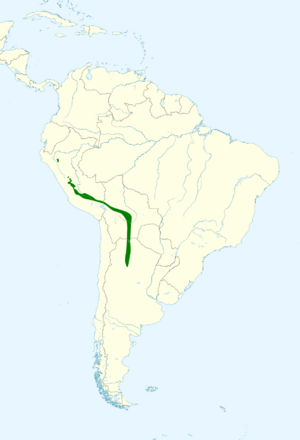Mitred parakeet facts for kids
Quick facts for kids Mitred parakeet |
|
|---|---|
 |
|
| A feral mitred parakeet in Florida | |
| Conservation status | |
| Scientific classification | |
| Genus: |
Psittacara
|
| Species: |
mitratus
|
 |
|
| Synonyms | |
|
Aratinga mitrata |
|
The mitred parakeet (Psittacara mitratus) is a type of parrot found in South America. It's also known as the mitred conure by people who keep birds as pets. These colorful birds are originally from Argentina, Bolivia, and Peru. Over time, some have been introduced to other places like Uruguay and parts of the United States, including California, Florida, and Hawaii, where they now live in the wild.
Contents
About the Mitred Parakeet
Scientists group animals into different families and species. The mitred parakeet belongs to the family Psittacidae, which includes African and New World parrots. For a while, this parakeet was placed in the Aratinga group, but since about 2013, it has been moved to the Psittacara group.
Scientists sometimes have different ideas about how to classify animals. For example, the International Ornithological Committee (IOC) recognizes three types, or subspecies, of the mitred parakeet:
- P. m. chlorogenys
- P. m. mitratus
- P. m. tucumanus
Other groups, like the American Ornithological Society (AOS), recognize a fourth subspecies. This shows how science is always learning and updating!
What Does a Mitred Parakeet Look Like?
Mitred parakeets are medium-sized birds, usually about 31 to 38 centimeters (12 to 15 inches) long. They weigh between 219 and 275 grams (7.7 to 9.7 ounces). Both male and female parakeets look very similar.
Most of their body is green. They have a unique purplish forehead and a patch of red on their face. This red color is usually around their eyes and can spread down their cheeks. Some birds might also have a little red on their upper legs or at the bend of their wings. Their eyes are surrounded by bare white skin, and their beak is a light, horn-like color. Young parakeets, called juveniles, have very little or no red color on their faces.
Where Do Mitred Parakeets Live?
The mitred parakeet's natural home is in South America. The P. m. mitratus subspecies lives from Peru south through Bolivia into northwestern Argentina. The P. m. chlorogenys subspecies is found on the eastern side of the Peruvian Andes mountains. The P. m. tucumanus subspecies lives in parts of Argentina.
These parakeets live in many different places, mostly where there are forests. This includes mountain forests, cloud forests, and even scrub areas in dry regions. They can be found at high elevations, sometimes as high as 4,000 meters (13,000 feet) in Peru!
Outside their native range, populations have grown from pet birds that escaped or were released. In places like California and Florida, they often live in cities and suburbs. In Hawaii, they live in both populated and wild areas.
Mitred Parakeet Behavior
How Do Mitred Parakeets Move?
Mitred parakeets often move around to find food. They also seem to travel more when it's not breeding season. These birds are very social and can be seen in large groups. While flocks of about 100 birds are common, some groups can have as many as 2,000 individuals!
What Do Mitred Parakeets Eat?
In their natural homes, mitred parakeets eat a variety of foods. Their diet includes berries, other fruits, seeds, nuts, and even maize (corn). In California, they have been seen eating fruits and flowers. In south Florida, they eat from many different types of plants, both native and introduced.
Reproduction and Life Cycle
In their native areas, mitred parakeets build their nests in holes in trees or on cliffs. A female usually lays two to three eggs at a time. In Florida, they often nest on human-made structures, and in Hawaii, they have nested on sea cliffs.
What Sounds Do Mitred Parakeets Make?
Mitred parakeets are very noisy birds! When they fly, they make a continuous, loud, screeching chatter. They also make squeaky, nasal notes and other screeches. Their loud calls can be heard from far away.
Conservation Status
The IUCN (International Union for Conservation of Nature) has listed the mitred parakeet as a species of "Least Concern." This means that in its native range, the bird is not currently at high risk of disappearing. They have a large area where they live, and even though we don't know the exact number of birds, their population seems to be stable.
In the past, many mitred parakeets were caught to be sold as pets. However, as of 2018, there are no major threats to their survival in the wild. They are generally common and found in many protected areas.
In California, about 1,000 mitred parakeets were estimated in 2002. The population in south Florida has been growing, reaching at least 400 birds by 2019. In Hawaii, the population was around 200 in 2003, but efforts to control their numbers reduced them to about 30 by 2012.
Mitred Parakeets as Pets
Aviculture is the hobby of keeping and breeding birds. The mitred parakeet subspecies often seen as pets in America is Psittacara m. mitrata. These birds are popular pets because they are known to be outgoing and playful.
They can even act like "watch birds" because of their loud, piercing alarm calls. Like most parrots, they often become very devoted to their human owners. They can also get attached to groups of people rather than just one person. Mitred parakeets can make great pets for people who are ready to spend time and money on them and understand their natural behaviors, like screaming, biting, and splashing.
Images for kids
See also
 In Spanish: Calancate cara roja para niños
In Spanish: Calancate cara roja para niños



